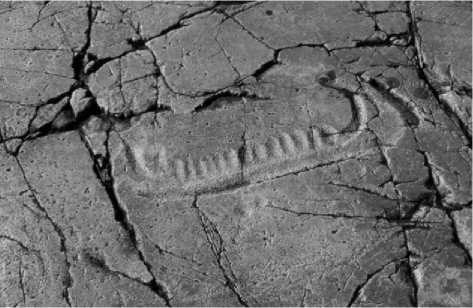The Bronze Age saw the flourishing of a rich tradition of rock art in which exposed surfaces of rock were engraved with depictions of objects, people, and symbols (see Rock Art). The two major provinces of Bronze Age rock art in western and northern Europe are found in Scandinavia and in the southern Alps. Each has its own characteristic repertoire of motifs.
There is hardly a rock outcrop with a smooth face in Sweden that escaped being used as the canvas for rock carvings. Most are concentrated along the west coast facing the North Sea, a region called Bohusliin, but they are also found in southern and central Sweden and adjacent parts of Norway and Denmark. The Tanum area in Bohusliin is the capital of Bronze Age rock carvings in Sweden. Several hundred separate carved outcrops are known in Tanum, and many more are known from adjacent districts. Hundreds more await discovery. When they were carved, the
Bohusliin engravings were along the shoreline, whereas today they are 25-30 m above sea level due to the postglacial rebound of the Swedish peninsula, which continues to rise even today.
The most common engraving is a very simple hemispherical pit 5-10 cm in diameter and a few centimeters deep, known as a ‘cup mark’. Cup marks are ubiquitous on Scandinavian rock outcrops. The significance of cup marks is completely unknown, for they do not represent any recognizable object, but the fact that so many of them were made means that they surely held some sort of symbolic meaning.
More interesting to archaeologists are the rock carvings that depict objects, animals, and humans, because they are trying to tell us something about the social and spiritual lives of Bronze Age people. Ships are by far the most abundant image, and thousands of carved watercraft with raised prows and sterns and often carrying people have been Recorded (Figure 3). Sleighs, trees, and weapons are also common motifs. When people are shown, they are often brandishing spears and swords, playing bronze trumpets, pushing plows, or riding chariots drawn by oxen. Many of the human images are unequivocally male. Animals include deer, bear, fish, birds, and whale. Abstract images are often of suns and spirals. Sometimes the artists traced their feet and hands.
Some of the Swedish carvings give the impression of planned compositions, while others seem more haphazard. Scenes of rituals, processions, plowing, and hunting depict at one level familiar elements of Bronze Age life, but we do not know the extent to which these carvings themselves were locations or backdrops for social activity or whether the capturing

Figure 3 Rock carvings, like this one from Scania in southern Sweden, cover boulders throughout Scandinavia and depict important aspects of Bronze Age life in northern Europe, such as seafaring using long boats with multiple rowers. Note the cup marks directly below the ship (photo © 2000 by Peter Bogucki).
Of these images had a deeper significance for the relationship between the world of the living and the world of myths and deities.
The other major province of Bronze Age rock art is found in the southwestern Alps of northern Italy and southeastern France. It is exemplified by two classic sites, Val Camonica in Lombardy, Italy, and Mount Bego in the French Alps-Maritimes. At both these sites, the tradition of carving on rock faces began during the Neolithic and continued into the Iron Age, but the Bronze Age carvings are classics of their genre.
At Mount Bego, some 100 000 individual images were carved into the schist and sandstone outcrops by hammering with a pointed metal or stone tool. The most common images are a schematic depiction of horned oxen, sometimes in pairs or fours pulling a plough. Bronze weapons and tools account for about 15% of the images. Matching them to dated finds of actual tools and weapons from archaeological deposits has proven to be a reliable way of dating the Mount Bego carvings. Enigmatic geometrical figures may be depictions of animal pens and fields. Human figures are rare, but they are often complex. One famous example has a circular head and zigzag arms, while others seem to be dancing or praying. The human figures also seem to be placed at special locations such as where travelers would have to pass.
Val Camonica has yielded over 200 000 carvings, and neighboring valleys contain still more. Traces of color suggest that many of the engravings were once highlighted with color. Some of the carvings appear to depict houses and workshops with pitched roofs, while others may be pictorial maps of fields and dwellings. People are engaged in activities like hunting, weaving, plowing, and metalworking. Weapons and tools are common motifs at Val Camonica as at Mount Bego, clearly reflecting the functional and symbolic importance of these objects for Bronze Age society.




 World History
World History









